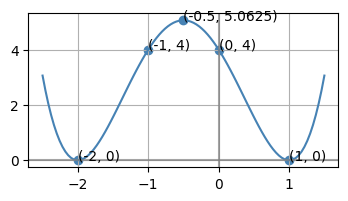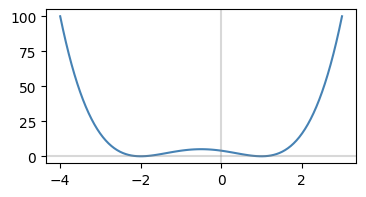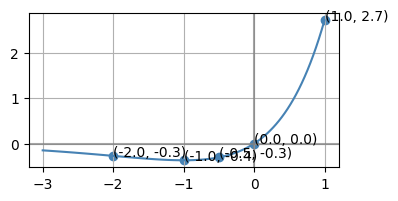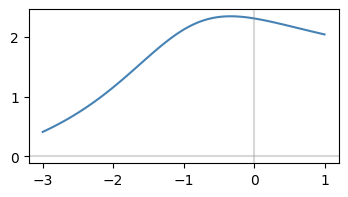練習問題メモ 02#
和達三樹. (2019). 微分積分. 第3章 練習問題
[4] 次の関数の\(n\)次導関数を求めよ#
(1) \(y=\frac{1}{x}\)
\(y=x^{-1}\)なので
\(n=1\)のとき、\(f'(x) = -1 \cdot x^{-2}\)
\(n=2\)のとき、\(f''(x) = -1 \cdot (-2) \cdot x^{-3}\)
\(n=3\)のとき、\(f^{(3)}(x) = -1 \cdot (-2) \cdot (-3) x^{-4}\)
\(n=4\)のとき、\(f^{(4)}(x) = -1 \cdot (-2) \cdot (-3) \cdot (-4) x^{-5}\)
よって一般に
(2) \(y=a^x \quad (a>0)\)
\((a^x)' = a^x \log a\)
\((a^x)'' = a^x (\log a)^2\)
(3) \(y=x^2 e^x\)
ライプニッツの公式
を使って
[5]#
[5] 助変数表示の微分 \(x\) と \(y\) が 1 つの変数 \(t\) の関数として \(x=f(t), y=g(t)\) の形で 与えられているとする. このとき, \(y\) は \(x\) の関数, または \(x\) は \(y\) の関数と考えてよく, \(t\) を助変数(パラメータ)または媒介変数という. 逆関数の微分法を利用すれば,
によって, 導関数を計算できる. これを用いて, 次の関数について, \(d y / d x\) を求めよ.
(1) \(x=a \cos t, \quad y=b \sin t\)
なので
(2) \(\displaystyle x=\frac{3 a t}{1+t^3}, \quad y=\frac{3 a t^2}{1+t^3}\)
なので
[6]#
[6] 双曲線関数
に対して,次のことを示せ.
(1) \(\frac{d}{d x} \sinh x=\cosh x\)
(2) \(\frac{d}{d x} \cosh x=\sinh x\)
(3) \(\frac{d}{d x} \tanh x=\frac{1}{\cosh ^2 x}\)
(1) \(\frac{d}{d x} \sinh x=\cosh x\)
合成関数と捉えれば\((e^{-1\cdot x})' = - e^{-x}\) なので
memo
(2) \(\frac{d}{d x} \cosh x=\sinh x\)
合成関数と捉えれば\((e^{-1\cdot x})' = - e^{-x}\) なので
(3) \(\displaystyle \frac{d}{d x} \tanh x=\frac{1}{\cosh ^2 x}\)
[7]#
[7] 次の関数の極値を求め, そのグラフの概形をかけ.
(1) \(f(x)=x^4+2 x^3-3 x^2-4 x+4\)
(2) \(f(x)=x e^x\)
(3) \(\displaystyle f(x)=\frac{x+4}{\sqrt{x^2+2 x+3}}\)
(1) \(f(x)=x^4+2 x^3-3 x^2-4 x+4\)#
極値
となる\(x\)を求める。
まず、因数\((x-a)\)の\(a\)を探索する。
因数定理より、\(f(a) = 0\)となる\(a\)があれば\((x - a)\)が因数になる。
\(a=1\)とすると\(f'(1) = 4 + 6 - 6 - 4 = 0\)なので\((x-1)\)が因数のひとつであることがわかった。
次に、組立除法で\((4x^3 + 6x^2 - 6x - 4) / (x-1)\)を求める
より商の\(4x^2 + 10x + 4\)と余り\(0\)が得られるので
\(4x^2 + 10x + 4\)は、たすきがけ法などで解くと\((4x + 2)(x+2)\)なので
より、\(f'(x)=0\)となる\(x\)は\(-2, -1/2, 1\)
極値のひとつは
グラフ


(2) \(f(x)=x e^x\)#
極値
\(f'(x)=0\)となる\(x\)は\(-1\)
極値は
グラフ
- 2 / np.exp(2)
-0.2706705664732254
- 1 / np.exp(1)
-0.36787944117144233

(3) \(f(x)=\frac{x+4}{\sqrt{x^2+2 x+3}}\)#
なので、
となり、
のため、
わからなかった
略解だと\(x=-1/3\)
from sympy import symbols, factor
x = symbols("x")
y = (x**2 + 2*x + 3)**(-1/2) - (1/2) * (x+4) * (x**2 + 2*x + 3)**(-3/2)
factor(y)
